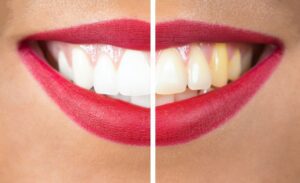Many of us strive to keep our smiles pearly white and bright. But a number of factors can cause your teeth to dull, darken, or otherwise diminish in color. If you suffer from dental discoloration, you can consult with your cosmetic dentist to find the best way to brighten your smile again.
However, tooth discoloration can also develop as a side effect of certain oral health concerns. When you know more about the different ways your teeth can become discolored, as well as their various causes, then you can better preserve your tooth color. Learn details about four types of dental discoloration that can accrue on your teeth and what they mean for your oral health when you read on.

Dark Tooth Stains
Brown or black spots can appear starkly disruptive against the naturally white color of your teeth. In many cases, this dark dental discoloration develops due to the foods, drinks, and other substances you consume. Darker foods and beverages get their color from tannins, particles that will transfer to your teeth and absorb into the enamel while you eat or drink.
Teeth-whitening treatment from your dentist can use bleaching gels to lift these stubborn stains and eradicate them. But dark tooth stains might also form as a side effect of tooth decay. Make sure that you visit your dentist to ensure these stains do not point to cavities.
Yellow Teeth
If your teeth begin to appear yellow in color, it might be because of staining agents in the items you consume as well. But yellow dental discoloration can also occur due to enamel erosion.
Your enamel serves to shield the more vulnerable inner layers of your teeth. Over time, enamel might wear down or erode for a number of reasons, including aging or poor oral hygiene. Worn enamel will reveal underlying dentin, which can appear yellow.
Enamel will not regenerate, so you will need to talk to your dentist to find appropriate ways to replace lost enamel and brighten your tooth color. Your dentist may suggest cosmetic or restorative dental solutions, depending on the severity of the enamel damage.
Grey or Dull Tooth Color
A grey or dull color in your teeth may point to an injury to the tooth pulp. The pulp features blood vessels that keep the entire tooth healthy. Under abnormal pressure, such as chronic teeth grinding or a blow to the face, you could hurt these blood vessels.
If your tooth pulp cannot receive enough blood, then it might become non-vital. The condition is not necessarily a dental emergency. But a dead tooth can appear awkward in your smile and be in danger of further dental issues. Learn more about how to monitor non-vital tooth pulp by calling your dentist.
White Spots on the Teeth
Though you want your teeth to appear pearly white, you might develop creamy white spots on your teeth that make the tooth color appear uneven. This discoloration appears when you have demineralization, or a lack of calcium in your tooth enamel.
It signifies a weakening in your dental structure. You will need to talk to your dentist about how to strengthen your teeth, prevent further dental concerns, and enhance your tooth color.

